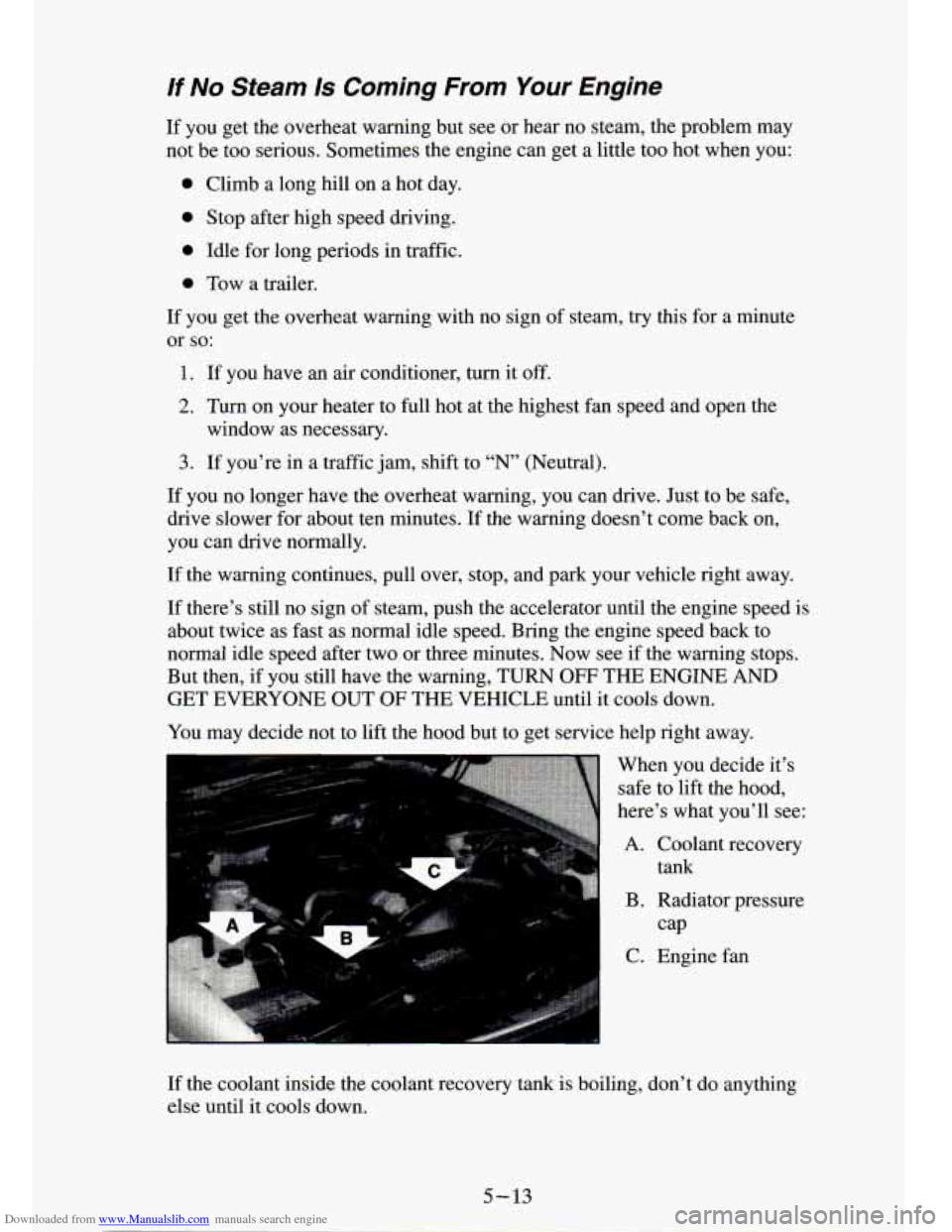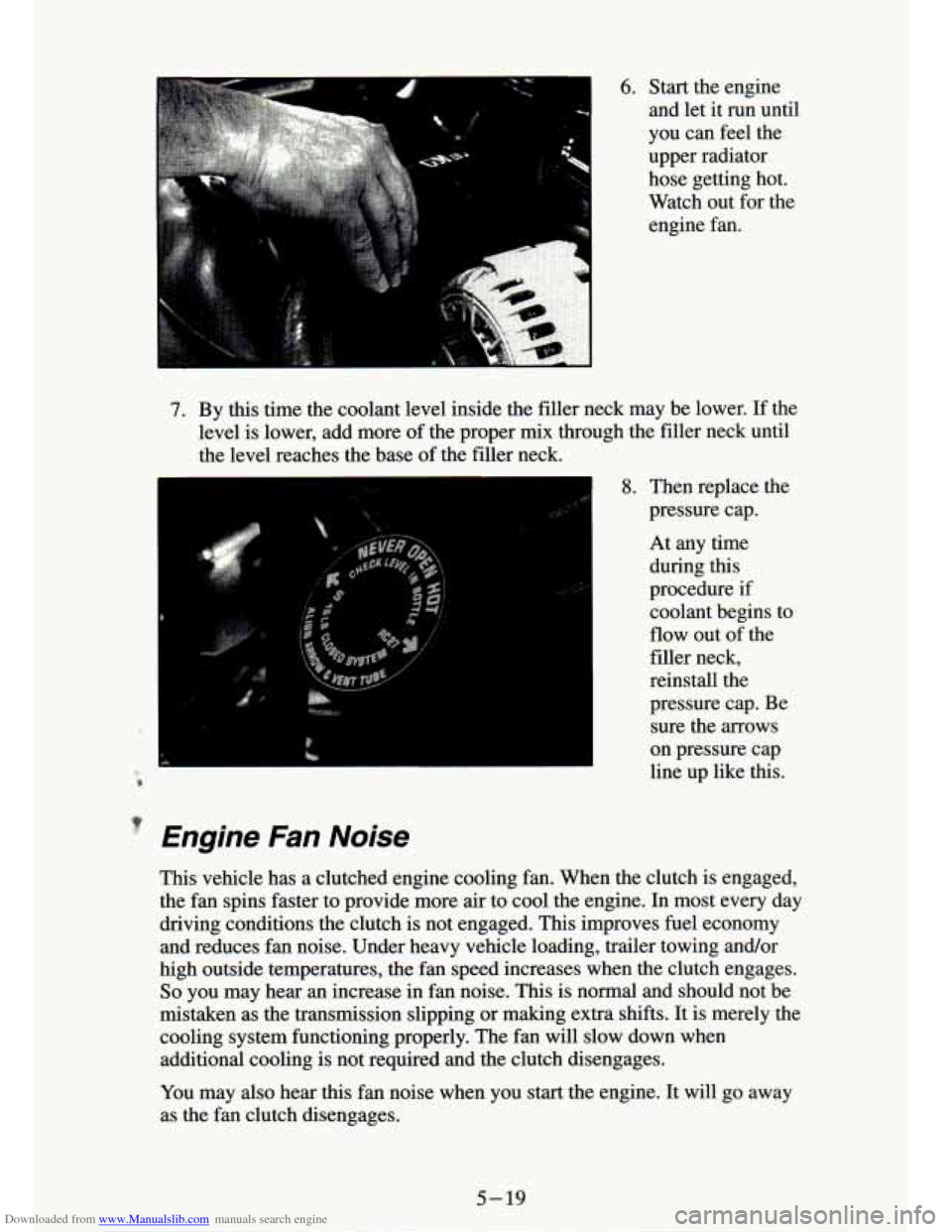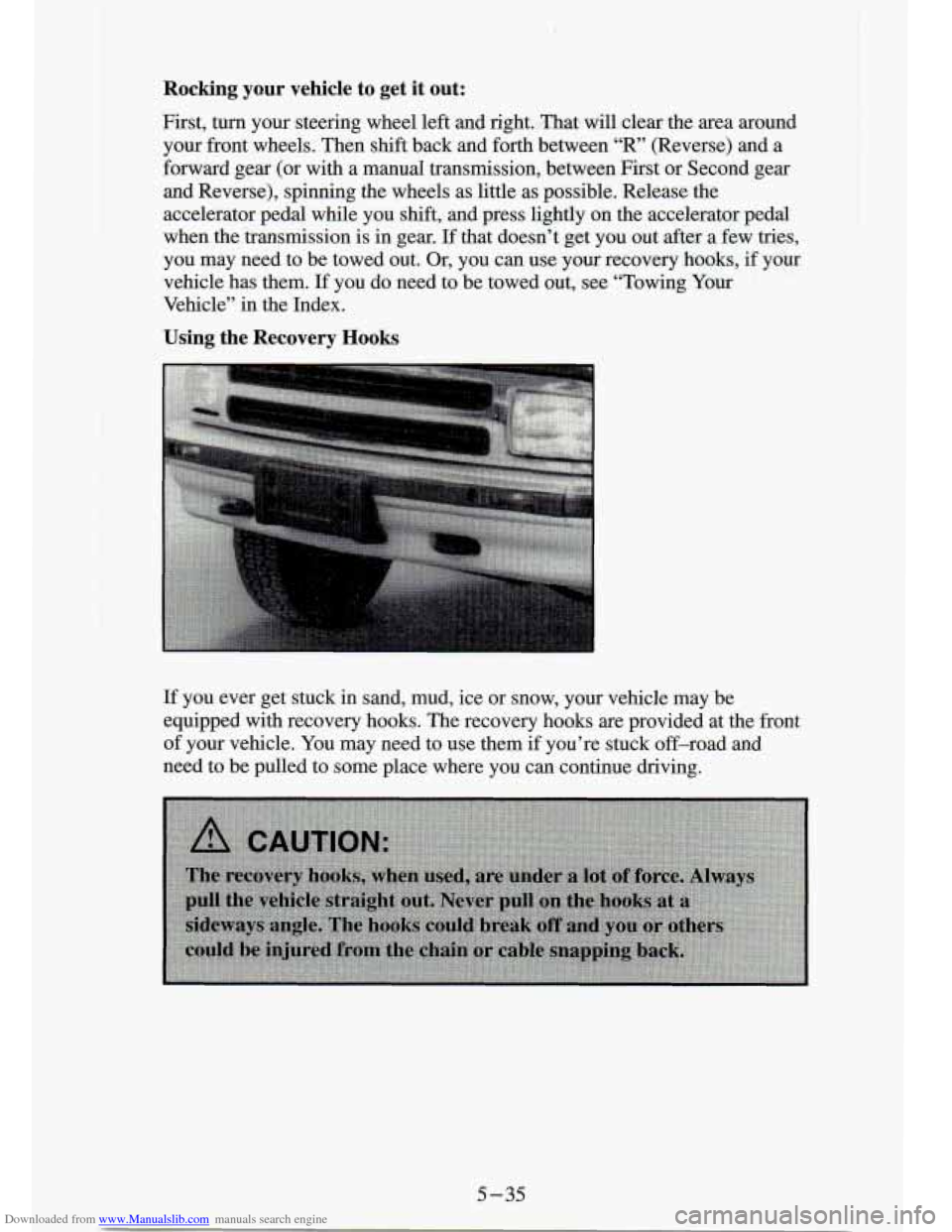Page 192 of 340
Downloaded from www.Manualslib.com manuals search engine Towing From fhe Front
NOTICE:
Do not tow with sling-type equipment or front bumper system
will be damaged.
Use wheel lift or car-carrier equipment.
Additional ramping may be required for car-carrier equipment.
Use safety chains and wheel straps.
If your vehicle has the four-wheel drive option, a dolly MUST be
used under the rear wheels when towing from the front.
5-19
Page 193 of 340
Downloaded from www.Manualslib.com manuals search engine Towing From the Rear
NOTICE:
Do not tow with sling-type equipment or rear bumper system
will be damaged.
Use wheel lift or car-carrier equipment.
Additional ramping may be required for car-carrier equipment.
: . .A. :i.-.
Use safety chains and wheel straps.
If your vehicle has the four-wheel drive option, a dolly MUST
be used under the front wheels when towing from the rear.
Don’t have your vehicle towed on the rear wheels, unless you have to. If the
vehicle must be towed on the rear wheels, don’t go more th\
an
35 mph (56
km/h) or farther than 50 miles (80 km) or your transmission will be
damaged.
If these limits must be exceeded, then the rear drive wheels have
to be supported on a dolly.
5-11
Page 195 of 340

Downloaded from www.Manualslib.com manuals search engine /f No Steam Is Coming From Your Engine
If you get the overheat warning but see or hear no steam, the problem may
not be too serious. Sometimes the engine can get a little too hot when you:
0 Climb a long hill on a hot day.
0 Stop after high speed driving.
0 Idle for long periods in traffic.
0 Tow a trailer.
If you get the overheat warning with no sign of steam, try this for a minute
or
so:
1. If you have an air conditioner, turn it off.
2. Turn on your heater to full hot at the highest fan speed and open the
window as necessary.
3.
If you’re in a traffic jam, shift to “N” (Neutral).
If you no longer have the overheat warning, you can drive. Just to be safe,
drive slower for about ten minutes. If the warning doesn’t come back on,
you can drive normally.
If the warning continues, pull over, stop, and park your vehicle \
right away.
If there’s still no sign
of steam, push the accelerator until the engine speed is
about twice as fast as normal idle speed. Bring the engine speed back to
normal idle speed after two or three minutes. Now see
if the warning stops.
But then,
if you still have the warning, TURN OFF THE ENGINE AND
GET EVERYONE
OUT OF THE VEHICLE until it cools down.
You may decide not to lift the hood but to get service help right away.
When you decide it’s safe to lift the hood,
here’s what you’ll see:
A. Coolant recovery tank
B. Radiator pressure
C. Engine fan
cap
If the coolant inside the coolant recovery tank is boiling, don’t do anything
else until it cools down.
5-13
Page 201 of 340

Downloaded from www.Manualslib.com manuals search engine 7. By this time the coolant level inside the filler neck may be lower. If the
level is lower, add more of the proper
mix through the filler neck until
the level reaches the base of the filler neck.
8. Then replace the
pressure cap.
At any time during
this
procedure if coolant begins to
flow out of the
filler neck,
reinstall the
pressure cap. Be sure the arrows
on pressure cap
line up like this.
P
' Engine Fan Noise
This vehicle has a clutched engine cooling fan. When the clutch is engaged,
the fan spins faster to provide more air
to cool the engine. In most every day
driving conditions the clutch is not engaged. This improves fuel economy
and reduces fan noise. Under heavy vehicle loading, trailer towing and/or
high outside temperatures, the fan speed increases when the clutch engages.
So you may hear an increase in fan noise. This is normal and should not be
mistaken as the transmission slipping or making extra shifts. It is merely the
cooling system functioning properly. The fan will slow down when
additional cooling is not required and the clutch disengages.
You may also hear this fan noise when you
start the engine. It will go away
as the
fan clutch disengages.
5-19
Page 202 of 340

Downloaded from www.Manualslib.com manuals search engine If a Tire Goes Flat
It’s unusual for a tire to “blow out” while you’re driving, especially if you
maintain your tires properly. If
air goes out of a tire, it’s much more likely to
leak out slowly. But if you should ever have a “blowout,”\
here are a few tips
about what to expect and what
to do:
If a front tire fails, the flat tire will create a drag that pulls the vehicle
toward that side. Take your foot
off the accelerator pedal and grip the
steering wheel firrnly. Steer to maintain lane position, then g\
ently brake to a
stop well out of the traffic lane.
A rear blowout, particularly on a curve, acts much like a skid \
and may
require the same correction you’d use in a skid.
In any rear blowout, remove
your foot from the accelerator pedal. Get the vehicle under co\
ntrol by
steering the way you want the vehicle to go. It may be very bumpy and
noisy, but you can still steer. Gently brake to a stop, well \
off the road if
possible.
If a tire goes flat, the next part shows how to use your jacking equipment to
change a flat tire safely.
Changing a Flat Tire
If a tire goes flat, avoid further tire and wheel damage by driving slowly to a
level place. Turn on your hazard waming flashers.
5-20
Page 206 of 340
Downloaded from www.Manualslib.com manuals search engine Underbody Carrier
NOTICE:
Never remove or restow a tire from/to a stowage position under
the vehicle while the vehicle is supported
by a jack. Always
tighten the tire fully against the underside
of the vehicle when
restowing.
I
5
Underbody Spare Tire Mounting
1. Wheel Wrench
2. Hoist Assembly
3. Retainer
4. Spring
5. Tire
6. Valve Stem (Pointed Down)
NOTICE:
To help avoid vehicle damage, do not drive vehicle before cable
is restored.
5-24
I
Page 214 of 340
Downloaded from www.Manualslib.com manuals search engine L
Put the nuts on by
hand. Make sure the
cone-shaped end
is
toward the wheel.
Tighten each nut by hand until the wheel
is held against the hub. If a nut
can’t be turned by hand, use the wheel wrench and see your dealer \
as soon
as possible.
Lower the vehicle by
rotating the
jackhandle to the left.
Lower the jack
completely. ..
5-32
k.
Page 217 of 340

Downloaded from www.Manualslib.com manuals search engine Rocking your vehicle to get it out:
First, turn your steering wheel left and right. That will clear the area around
your front wheels. Then shift back and forth between
“R’ (Reverse) and a
forward gear (or with a manual transmission, between First or \
Second gear and Reverse), spinning the wheels as little as possible. Release the
accelerator pedal while you shift, and press lightly on the accelerator pedal
when the transmission is
in gear. If that doesn’t get you out after a few .tries,
you may need to be towed out. Or, you can use your recovery hooks, if your
vehicle has them.
If you do need to be towed out, see “Towing Your
Vehicle” in the Index.
Using the Recovery Hooks
If you ever get stuck in sand, mud, ice or snow, your vehicle may be
equipped with recovery hooks. The recovery hooks are provided at the front
of your vehicle. You may need to use them if you’re stuck off-road and
need to be pulled to some place where you can continue driving.
5-35